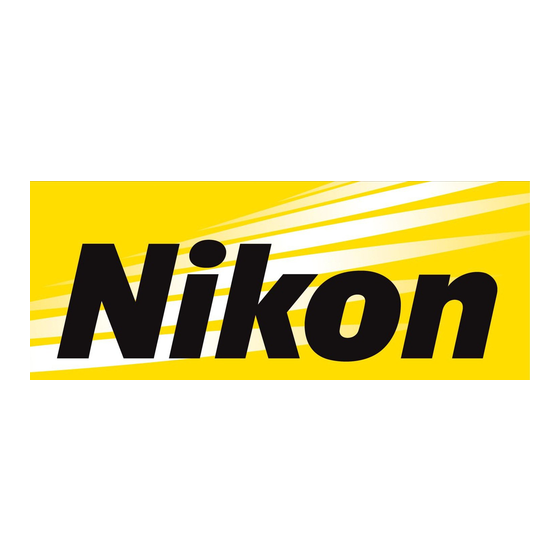Nikon Coolpix 990 Manual de início rápido - Página 2
Procurar online ou descarregar pdf Manual de início rápido para Acessórios para câmaras Nikon Coolpix 990. Nikon Coolpix 990 2 páginas. Recommended camera settings for oneshot360
Também para Nikon Coolpix 990: Nota de lançamento (4 páginas), Manual Fast Track (1 páginas), Referência rápida (4 páginas), Opinião do utilizador (50 páginas), Instruções de configuração (2 páginas)

Nikon Coolpix 990 Help
Adjusting the Metering:
5
Metering allows the camera to determine how much
light is necessary for illuminating a certain picture.
You should use Center-Weighted metering for intra-
oral pictures, as it allows you to preserve background
detail while providing the right amount of light output
for the teeth. To select this, click on the Menu button
on the back of the camera and use the Selector button
to navigate to the Metering option, as shown below.
When Center-Weighted is highlighted, push on the
right arrow of the Selector button to select.
Selector Button
Tips for Taking Intraoral Images
For intraoral images, we recommend taking pictures about 6 inches from the patient's mouth. This
allows the flash to meter correctly without overexposing the picture. With the camera's high resolu-
tion, you will not lose clarity when cropping the images.
When you are taking the buccal and frontal intraoral pictures, make sure to take the picture at a 90º
angle to the teeth. Also, try to align the horizontal plane of the camera with the patient's occlusal
plane. This will save time, as you will not have to rotate the image inside Quick Ceph later.
NOTE: The flash is located on the left side of the camera. When taking right side buccal pictures,
we recommend turning the camera upside down. This eliminates shadows and gives you images with
consistent exposure and color. The image can then be rotated inside Quick Ceph.
For occlusal pictures, we recommend framing the picture in the LCD monitor and leaving a left and
right margin. If the picture is taken too close, it may not fit within the cropping windows. We rec-
ommend using mirrors for the occlusal pictures.
C
Adjusting Images While in QCIPro and QC2000
Rotating Intraoral Images Inside QCIPro and QC2000
To flip mirror pictures within QCIPro and QC2000, use the Flip tool located on the Tool Bar. Make
sure the intraoral images are displayed on-screen. Click on the Flip tool and from the display box
that appears, choose the image that you would like to flip across the mirror plane.
If you've taken your right buccal pictures by turing your camera upside down, the image must then
be re-rotated 180º using the Flip tool. To simulate a 180º rotation, the image must be flipped both
horizontally and vertically. First, flip the picture horizontally by clicking on the Flip tool. To flip the
buccal picture vertically, hold down the "option" key before clicking on the Flip tool.
The Rotate 90º tool is used to rotate extraoral images 90º in QC2000. Clicking on this tool rotates
the image clockwise. For counterclockwise rotation, hold down the "option" key and click on the 90º
tool. This tool is not available in QCIPro.
Please Note: We only recommend this camera. We do not manufacture it. If you have technical difficulties, please contact Nikon Support
at 1-800-645-6689.
http://www.quickceph.com/docs/1028Nikon_990_help.pdf
Quick Ceph
Adjust the Speedlight settings:
6
To eliminate overexposure for intraoral pictures,
you can adjust the flash output of Nikon's
Speedlight. To do this, click on the Menu button
on the back of the camera, then select the
Choose "Variable Power" as shown in the picture
below. We recommend using a setting of -1.3 for
intraorals. However, you may need to adjust this
value to fit the lighting in your office.
Page 2
®
Systems
icon.
After all of the adjust-
ments have been made,
the Control Panel at the
top of the camera should
resemble the image
shown below.
Manual Mode with:
Macro setting
Anytime Flash
ISO 400 setting
Aperture Priority
Center Weighted Metering
Reduced Flash output
If the occlusal pic-
tures appear too
dark, you should set
the camera to the A-
mode and turn on
the Macro. This
adds more light to
the occlusal pictures.
Doc ID# 1028Nikon_990_help - Revision 12-13-00
TIP
